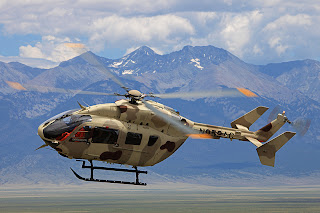Thanks for the article William...
via the UPI.com. Highlighted areas are by SNAFU! Comment on those follows the article.
Israelis favor V-22 Osprey for special ops
Published: June 7, 2011 at 2:59 PM
TEL AVIV, Israel, June 7 (UPI) -- The
Israeli air force is sending a team to the United States this month to
evaluate the controversial V-22 Osprey tilt-rotor aircraft that it's
eyeing for search-and-rescue and covert special operations.
The successful March rescue of a downed U.S. Air Force F-15 pilot in
Libya by an Osprey crew has doubtless enhanced the prospects of the
multi-mission aircraft built by Bell Helicopter and Boeing Rotorcraft
Systems.
"The (Israeli air force) has had its eye on the V-22 for a number of
years and senior officers, including Chief of Staff Lt. Gen. Benny Gantz
have flown in it and were impressed with its capabilities," The
Jerusalem Post reported Tuesday.
The air force had initially looked at the Osprey as a replacement for
its aging fleet of Sikorsky CH-53 Sea Stallion transport helicopters.
But these days, the Post added, "due to the V-22's smaller size it is
being looked at a complementary platform to assist in (Israeli air
force) search-and-rescue operations and dropping Special Forces behind
enemy lines."
Once the air force team has fully examined the V-22 in the United
States, the service's helicopter directorate will submit a
recommendation to the air force commander, Gen. Ido Nehushtan.
The V-22 can carry 24 fully equipped combat troops seated -- 32 floor
loaded -- or more than 19,800 pounds of internal or external cargo. It
has a range of 2,500 miles with a single in-flight refueling.
The Osprey is unique because it has vertical takeoff and landing
capability like a helicopter, with the rotors of its two end-of-wing
Rolls-Royce AE 1107C engines in the upright position.
It can shift the three-bladed rotors 45 degrees so they operate as
propellers pushing the aircraft forward, with short-takeoff and landing
capability.
It can reach speeds of 350 miles per hour, about double that of a traditional helicopter.
The Osprey was first designed in the 1950s but the first V-22 wasn't
rolled out until May 1988. Since then its development has taken years
because of the complexity and difficulties of being the first tilt-rotor
designed for military service.
It has had to overcome a series of political, funding and technical
battles that threatened to scrap the project before it was certified for
operational deployment.
Despite a series of high-profile fatal accidents involving the V-22, the
Pentagon approved full-rate production in September 2005.
The U.S. Marine Corps deployed the MV-22 in 2007 and has been steadily
replacing its CH-46 Sea Knights on a squadron-by-squadron basis. The
switch is due to be completed by 2019.
The U.S. Army deployed Ospreys in 2009 and it has seen combat in Iraq,
Afghanistan and Libya. It made its combat debut in Iraq's turbulent
Anbar province, an insurgent hotbed, in November 2007(SNAFU! Note. This has to be an error or I've been missing some really big news).
The Israeli air force team that will evaluate with V-22 will note that
the U.S. Marines in Afghanistan, where the Osprey was deployed in
November 2009, found that the V-22's speed and range made it a good
operational match for fast combat jets.
The Marines thus split Marine Expeditionary Unit operations into two
groups, one with fixed-wing jets and V-22s, the other with slower
helicopters.
The U.S. Air Force's first operational CV-22 was delivered to the 58th
Special Operations Wing at Kirtland Air Force Base, N.M., in March 2006.
The aircraft is currently deployed with three Special Operations
Squadrons.
There are 112 V-22s operational with U.S. forces. The Marine Corps has ordered 360 of the aircraft, each costing $110 million.
The U.S. Air Force Special Operations Command wants 50 and the U.S. Navy is expected to acquire 48.
Just a few comments on the sections I highlighted...
1. I wrote an article a while ago (
read it here) which covered the aftermath of the Israeli CH-53 crash in Romania. In that article an Israeli General was quoted as saying that only the CH-53K could perform future missions. IF this article is true then it appears that the Israeli Air and Space Force is tailoring its forces to almost mirror the Marine Corps. That's a good sign.
2. I never knew the US Army even operated Ospreys and unless I'm in error they're talking about the combat debut of the Marine's MV-22.
3. This has been a personal area of concern with the MV-22. If the AH-1Z was the primary escort then the speed advantage of the MV-22 would have been negated. Those in the planning section I see already settled on fast movers to do the job instead.
4. Is the Navy still on tap to purchase V-22's? I thought that they allowed the requirement to die. Time for some Googling to find out what's what with that part of the story.
SIDENOTE:
A reporter today stated that the rescue was the result of the Marine Corps being glory seeking. These are his exact words...
The
U.S. Marine Corps has gotten a lot of attention for its MV-22 mission,
this year, to rescue one of two downed F-15 pilots when the fighter went
down in Libya owing to mechanical problems.
But
the U.S. Air Force Special Operations Command (AFSOC), not as publicity
hungry or savy, has quietly carried out a far more significant search
and rescue mission using its tiltrotor.
He owes the Marine Corps an apology. It won't come but he does owe it.

























































